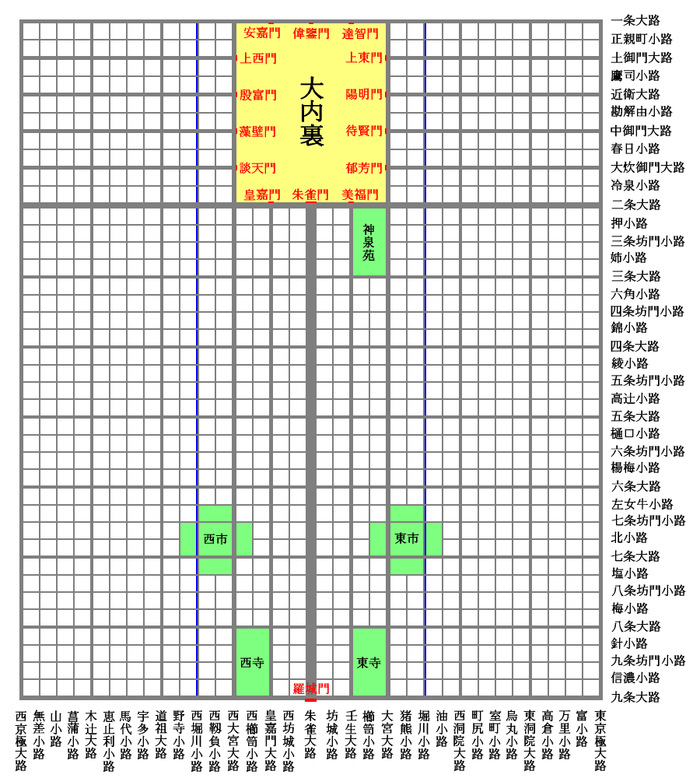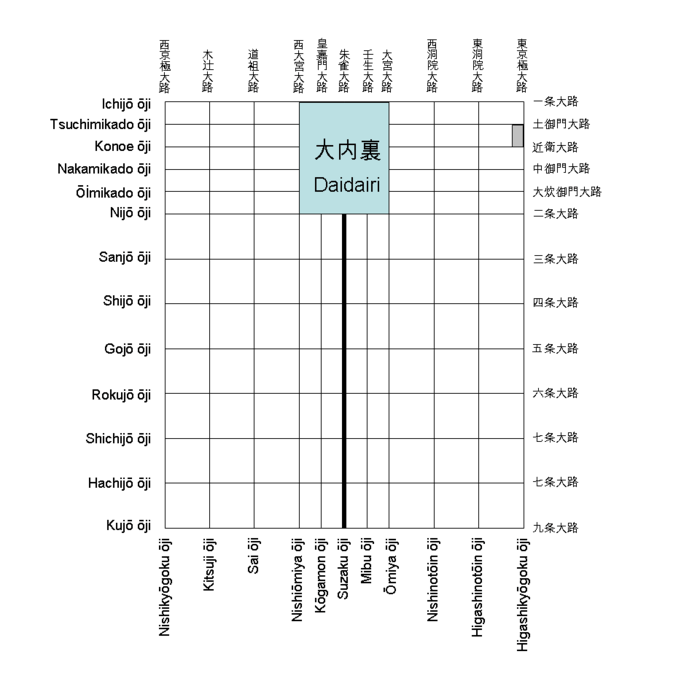Heian-kyō

Heian-kyō (平安京, literally "tranquility and peace capital") was one of several former names for the city now known as Kyoto. It was the capital of Japan for over one thousand years, from 794 to 1868 with an interruption in 1180.
Emperor Kanmu established it as the capital in 794, moving the Imperial Court there from nearby Nagaoka-kyō at the recommendation of his advisor Wake no Kiyomaro and marking the beginning of the Heian period of Japanese history.[1] The city was modelled after the Tang dynasty Chinese capital of Chang'an (modern-day Xi'an).[2] It remained the chief political center until 1185, when the samurai Minamoto clan defeated the Taira clan in the Genpei War, moving administration of national affairs to Kamakura and establishing the Kamakura shogunate.
Though political power would be wielded by the samurai class over the course of three different shogunates, Heian remained the site of the Imperial Court and seat of Imperial power, and thus remained the official capital. In fact, even after the seat of Imperial power was moved to Tokyo in 1868, since there is no law which makes Tokyo the capital, there is a view that Kyoto legally or officially remains the capital even today.
In 1994, Kyoto City held various events commemorating the 1200th anniversary.
Description
Heian-kyō was built in what is now the central part of Kyoto city covering an area spanning the Kadono (愛宕郡 Kadono-gun) and Otagi Districts (愛宕郡 Otagi-gun) of Yamashiro Province (山背国 Yamashiro no Kuni). Kuni and gun are different types of administrative districts in use between the Nara and Meiji periods.) The city boundaries formed a rectangle measuring 4.5 km from east to west and 5.2 km from north to south. The city layout followed Heijō-kyō (Japan’s capital during the Nara period) with the Imperial palace, Daidairi, placed in the centre of the northern city limits and the Suzaku Avenue (Suzaku-oji), the main thoroughfare extending from the palace down through the centre of the city, dividing it into the Right (Ukyō) and Left Capitals (Sakyō) (the eastern side being the Left and the western side being the Right from the emperor's viewpoint.) The design followed Sui and Tang dynasty Changan with the exception that Heian-kyō had no city walls. It is thought that the site for the city was selected according to the principles of Shijinsoō (四神相応 Shi-jin Sōō) based on Chinese Feng shui. Shijinsoō (lit. “Four God Suitability”) relates to the Four Symbols of Chinese astrology.
The boundaries of Heian-kyō were smaller than those of modern Kyoto, with Ichijo-oji (一条大路) at the northern limit corresponding to present-day Ichijo-dori (一条通), between Imadegawa-dori (今出川通) and Marutamachi-dori (丸太町通), Kyujo-oji in the south corresponding to Kujo-dori (九条通) slightly to the south of the present-day JR Kyoto Station and Higashi-kyogoku-oji in the east corresponding to present-day Teramachi Street (Teramachi-dori). The location of Nishi-kyogoku-oji at the western limit is estimated as a line running north to south from Hanazono Station on the JR San'in Main Line to Nishi-Kyōgoku Station on the Hankyu Kyoto Line.
The layout of Heian-kyō was plotted in accordance with the principles of geomancy as a square city. Jo (丈, about 3.03m) was the basic unit of measurement. 40² Jo (丈) made a Cho (町, 121.2 meters on each side). The city was further divided by major streets called Oji (大路) and minor streets called Koji (小路). Four lines of Cho running east to west (excepting the first 2 rows in the north) were together called a “Jo” (条) and four lines of Cho running from north to south were called a “Bo” (坊) The Cho which shared the same Jo and Bo were each given a number from 1 to 16. In this way addresses could be identified as follows: "Right Capital, Jo Five, Bo Two, Cho Fourteen" (右京五条二坊十四町).
The width of even the minor streets was 4 Jo (丈, about 12m) and for the major streets over 8 Jo (丈, about 24m). Almost all of the streets in present-day Kyoto have become considerably narrower. Suzaku-oji for example was 28 Jo (丈, about 84m) wide. In addition a river ran alongside Horikawa-koji (堀川小路) and Nishi Horikawa-koji (西堀川小路).
History
In 784 AD emperor Kammu constructed Nagaoka-kyō, moving the capital from Heijō-kyō. It is thought that he wished to build a new, Emperor Tenji faction capital far from Yamato Province which was the power base for the temples and aristocrats who supported the Emperor Tenmu faction. However, only 9 years later in January 793 AD, Emperor Kammu assembled his retainers and announced another relocation of the capital (for the reason see the entry on Nagaoka-kyō.) The location for the new capital was to be Kadono located between two rivers in the north of Yamashiro, ten kilometres to the northeast of Nagaoka-kyō. It is said that the Emperor Kammu had previously looked out on Kadono from the Shogun Tsuka in Higashiyama Ward of Kyoto City, deciding then that it was a suitable location for the capital. Emperor Kammu's words are recorded in the Nihongiryaku as follows: “Kadono has beautiful mountains and rivers as well as good transport links by sea and land making it convenient for people to assemble there from all four corners of the country.”
It is thought that the construction of Heian-kyō began from the palace, with the construction of the remainder of the city following afterwards. As a display of the emperor's authority the Daigokuden (main building of the palace) was constructed at the far north of the central thoroughfare, Suzaku-oji, making the building visible from anywhere in the city. Ports such as Yodonotsu (淀津, now Yodo) and Ōitsu (大井津) were set up along the river next to the city. These ports acted as a transit base for collecting in goods from all over the country and for forwarding them on to the city. The goods which arrived in Heian-kyō reached the people by way of one of the two large markets (the East market and the West market.) This arrangement provided a stable supply of food and goods which encouraged population growth. Measures were also taken to guard against the flooding which had plagued the residents of Nagaoka-kyō. Although there was no natural river in the centre of Heian-kyō, two artificial canals (the present day Horikawa and Nishi Horikawa) were dug whose water level could be adjusted, simultaneously securing a supply of water and guarding against flooding. It was also permitted to construct Buddhist temples in Heian-kyō, something which had been forbidden in Nagaoka-kyō. It was thought that the power of the East and West temples might protect the city from natural disaster and disease, and priests like Kukai were welcomed, being able men, well versed in Buddhist scripture and with no interest in political power. On 22 October 794 AD, Emperor Kammu arrived at the new city and on 8 November proclaimed “I hereby name this city Heian-kyō.”On 8 November, he changed the second kanji character of Yamashiro from 背 ("back") to 城 ("castle") because the capital looked like a naturally formed "mountain castle" surrounded by the Eastern (Higashiyama), Northern (Kitayama), and Western (Nishiyama) mountains.
A movement in favour of returning the capital to Heijō-kyō arose in 810 AD, during a standoff over the emperor's succession. However, Emperor Saga thought that keeping the capital in Heian-kyō would be best for the stability of the country and resisted this movement, naming Heian-kyō "The Eternal City" (万代宮 "Yorozuyo no Miya").
The land of the Right Capital overlapped the wetlands formed by the Katsura River and even by the 9th century little progress had been made in developing the area. By the 10th century when the Ritsuryō system was almost at an end, the district had become so dilapidated that it began to be used as farmland, something which had previously been forbidden within the city limits. With the exception of an area in the north of the Right Capital near to the palace, the residential areas which housed the aristocracy were all situated in the Left Capital, with the highest echelon of aristocrats such as the Fujiwara clan gathering in the northernmost part of the district. The poor of Heian-kyō began to set up home by the Kamo River, beyond the eastern limits of the city, and on the eastern banks of the river temples and country homes sprung up. So started a tendency for the city to extend out to the east. In 980 AD, at the southern tip of Suzaku-oji the Rashōmon (the grandest of the two city gates) collapsed never to be rebuilt. In this way the original borders of Heian-kyō extended out to the east, forming the streets of first medieval and then modern-day Kyoto.
With the advent of the Kanto centred Kamakura and Edo Shogunate, Heian-kyō began to lose its significance as a seat of power. The greatest decline was during the Muromachi and Sengoku periods when almost half the city was burnt to the ground during the Onin war. After this Heian-kyo separated into upper (Kamigyō) and lower (Shimogyō) cities each becoming places of little note. However, the two were to be reunited into one city during the Azuchi-Momoyama Period following the ascension of Oda Nobunaga. During the Meiji Revolution Edo was re-christened Tokyo (becoming the new capital of Japan). Although Heian-kyo lost its status as capital city, it became a backup capital while the emperor was away in Tokyo. Since that time the emperor has not returned to Kyoto. However, at the direction of the Emperor Meiji, the imperial residences have been preserved and the takamikura (高御座)—a special throne whose location traditionally marked the seat of the emperor—remains at the palace in Kyoto.
Schematic diagram of Heian-kyō
The green areas in the diagram are markets, temples and a garden. There were two large markets, West Market (西市) and East Market (東市), facing the seventh street, Shichijō-ōji (七条大路). Tō-ji (東寺, "East Temple") and Sai-ji (西寺, "West Temple") were Buddhist temples built on the southern edge of the capital. An imperial garden called Shinsenen (ja:神泉苑) was adjacent to the Daidairi.
Note that there were more paths cut short by residences straddling multiple blocks.

In English (major streets and palace only):
- Note: "七条大路" erroneously listed twice in the diagram.

Gates
The gates of the Daidairi are marked in Japanese. The romanization of those gate names are as follows:
|
...... ......
......
...... ...... ...... ...... ......
|
Map
Below is a 1696 map of Kyoto, known as Genroku 9 Kyoto Daizu (元禄九年京都大絵図) held by the International Research Center for Japanese Studies (Nichibunken).
_Japanese_Map_of_Kyoto%2C_Japan_-_Geographicus_-_Kyoto-genroku9-1696.jpg)
See also
| Wikimedia Commons has media related to Heian-kyō. |
- Heian Palace
- Kyoto
- Chiteiki, a mid-Heian period text describing social issues within the capital
- Timeline of Kyoto
References
- ↑ Hall, John Whitney (1988). The Cambridge History of Japan. Cambridge University Press. pp. 516–17. ISBN 0521223571.
- ↑ Ebrey, Walthall & Palais 2006, p. 103.
| Preceded by Nagaoka-kyō |
Capital of Japan 794–1180 |
Succeeded by Fukuhara-kyō |
| Preceded by Fukuhara-kyō |
Capital of Japan 1180–1868 |
Succeeded by Tokyo |
Coordinates: 35°00′N 135°46′E / 35.000°N 135.767°E